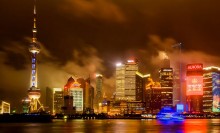Stephen Toope
If you’ve grown up in Canada, your mental picture of the world probably has Europe in the middle flanked by the “new world” of the Americas to the left and Asia to the right – the schoolroom Mercator map. Those growing up in China may be more familiar with the map created in 1602 by Italian missionary Matteo Ricci. He shows China at the centre of the known universe. Ricci’s annotation: “The Middle Kingdom is renowned for the greatness of its civilization.”
The Middle Kingdom is on the move. Over the past several decades, we in North America have considered the United States to be dominant in the world order. We refer to China as an “emerging economy.” This is understandable in the sense that over that period it has succeeded in lifting some half a billion citizens out of poverty. Its investments have both raised the quality of life for Chinese people and had a huge positive impact on the economic health of countries around the globe, including Canada’s.
What is perhaps less understood is the extent to which China has been quietly buying assets and influence outside its borders. More than a decade ago, it recognized Africa as both a source of natural resources and a growing, largely untapped market. China is now a major economic and political player on the continent. Joseph Wong of the Munk School has written of China’s “one belt, one road” economic plan that combines major commercial and infrastructure investments (to the tune of $40-billion U.S.) westward along the historic Silk Road route to Europe and southward to maritime ports in Southeast Asia. He asks, “Is China an imperialist power?”
It’s a question to which we must pay extraordinarily close attention. While it never took to colonization along the European model, for centuries China was ruled by quasi-divine dynastic emperors to whom lesser leaders in the region voluntarily paid tribute. Imperialism is not an unknown concept. China’s history took a sideways shift through huge upheavals in the 20th century and it turned inward. Since the 1970s it has become increasingly engaged internationally – taking its seat on the UN Security Council, joining the World Trade Organization, hosting the Olympics.
With the US, the world’s largest economy, now threatening to turn inward, it’s logical for China as the second-largest to move to fill the vacuum. President-elect Donald Trump declares his intent to create his own version of the Great Wall, tear up NAFTA and put the Trans-Pacific Partnership (designed to counterbalance Chinese influence) in peril. Xi Jinping, China’s president (also styled Paramount Leader) heads to Latin America – the US backyard – armed with trade and investment deals and aggressively promotes its TPP alternative – the Regional Comprehensive Economic Partnership, which includes India and Japan but not the US or Canada.
China has a rich culture and the potential to be a positive contributor to the world order. Yet we should have concerns. It has become increasingly belligerent over territorial claims in the South China Sea. It has nuclear capability, the world’s largest standing army, and is investing heavily in defense. Its relations with Hong Kong and Taiwan and Tibet are tense. The Munk School’s Lynette Ong has been watching two Chinese government campaigns – against corruption, which we should applaud (with caveats on lack of transparency and potential destabilization), and against dissent, which we should resist. The Citizen Lab at the Munk School has been examining the increasing sophistication of the government’s ability to censor digital media and track sensitive personal data that could put individuals’ security at risk. We are seeing repression of religious expression and those advocating human rights.
Canada on its own has limited ability to influence this world superpower. But we can monitor what’s happening and speak out. It may be a bumpy ride.
December 15, 2016
